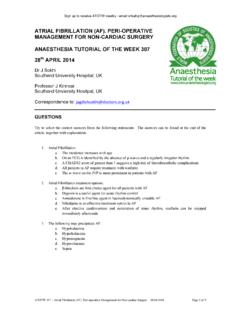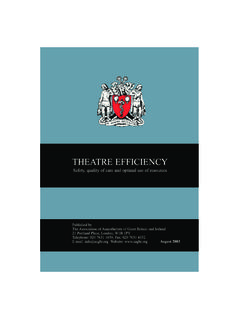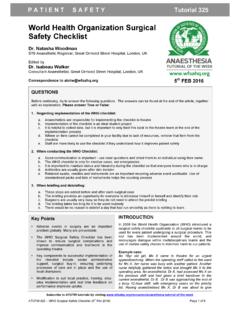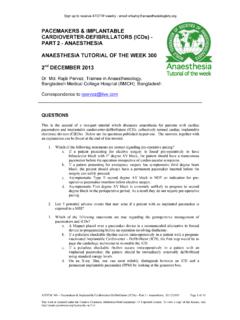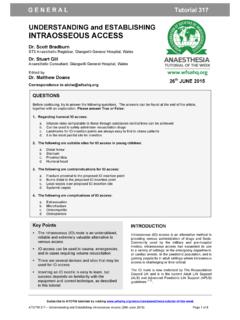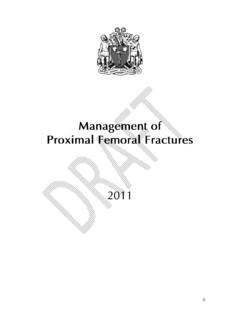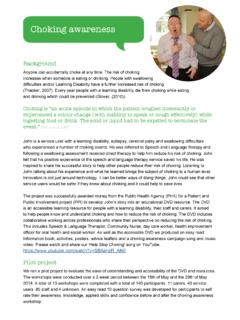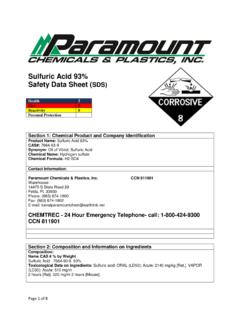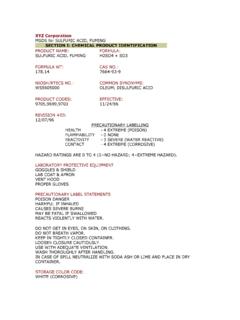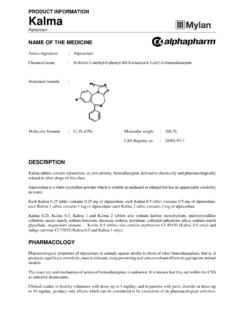Transcription of 291 Obesity and Day Case Surgery - AAGBI
1 Sign up to receive ATOTW weekly - email Obesity AND DAY case ANAESTHESIA. ANAESTHESIA TUTORIAL OF THE WEEK 291. 2ND SEPTEMBER 2013. Dr Swapna Sharma Dr Martin Watson Crosshouse Hospital, Kilmarnock, UK. Correspondence to QUESTIONS. Before continuing, try to answer the following questions. The answers can be found at the end of the article, together with an explanation. 1. Is there a safe limit of Body Mass Index (BMI) for day case Surgery ? 2. True or false: a. Patients with obstructive sleep apnoea should always be managed as inpatients. b. Guidelines for the management of the difficult intubation differ for inpatient versus day case Surgery . c. Regional anaesthesia is contraindicated in day case procedures. d. Obesity related complications associated with anaesthesia usually occur in the perioperative or immediate recovery phase. 3. The Stop Bang questionnaire includes the following? a. Snoring b. BMI. c. Oximetry d. Neck circumference INTRODUCTION. Obesity is a growing problem all over the world, particularly in westernised countries.
2 According to a recent WHO publication, being overweight or obese is the fifth leading risk for global deaths (1). Body mass index (BMI) is the most common method used to classify adult weight. It is defined as weight in kilograms divided by the square of height in metres (kg/m2). Table 1 shows BMI ranges as defined by the World Health Organisation (WHO). 61% of the UK population is overweight (BMI >25 kg/m2). In 2010, just over a quarter of adults were classified as obese (BMI >30 kg/m2) by the NHS Information Centre. With Obesity prevalence increasing at the same rate, it was predicted that in 2012 of men and of women would be classified as obese. By 2015, the foresight report estimates that 36% of males and 28% of females (aged between 21 and 60) will be obese and by 2025 it is estimated these figures will have risen to 47% and 36% respectively (2).. In the USA, more than one-third of the adult population suffers from Obesity (3). ATOTW 291 obesity and day case Anaesthesia, 02/09/2012 Page 1 of 9.
3 Sign up to receive ATOTW weekly - email Table 1. Classification BMI (kg/m2). Normal range 25. Overweight 25. Pre-obese 25 30. Obese 30. Obese class I 30 35. Obese class II 35 40. Obese class III (morbidly obese) 40. SELECTION CRITERIA IN THE DAY Surgery UNIT. Complications associated with Obesity usually occur intra-operatively or in the immediate recovery phase although they can occur at later stages. Day case anaesthesia provides benefit to these patients by promoting early mobilisation and reducing the incidence of hospital acquired complications such as infection. The Association of Anaesthetists of Great Britain and Ireland ( AAGBI ) state that even morbidly obese patients can be safely managed as day cases by expert staff with appropriate resources and that the absolute level of BMI should not be used as the sole indicator for suitability for day case Surgery . In 1992, the Royal College of Surgeons recommended that patients with a BMI of greater than 30 kg/m2.
4 Should be excluded from day case procedures (4). However, in 2002, the NHS Modernisation Agency raised the limit to at least 35 kg/m2 and up to 40 kg/m2 for many procedures (5). It has now become common practice to accept for day Surgery patients in whom management would not be altered by in- patient admission. The fourth edition of the British Association of Day Surgery directory of recommended day Surgery and short stay surgical procedures was published in June 2012. It contains over 200 procedures categorised by surgical specialty and assigns each procedure to one of four treatment options - Procedure room, Day case , 23 hour stay and under 72 hours stay. It also includes a National Dataset of outcomes for England during 2011 showing the percentage of procedures successfully carried out on a day case basis (6). PREOPERATIVE ASSESSMENT. Co-morbidities An extensive preoperative assessment is needed to elicit co-morbidities as many obese patients have a high prevalence of conditions such as hypertension, ischaemic heart disease, diabetes, hypercholesterolaemia and gastric reflux.
5 See Anaesthesia Tutorial of the Week 21 ( Obesity and Anaesthesia) for a more comprehensive review of the systemic complications of Obesity . This tutorial will go into further depth on the subject of obstructive sleep apnoea, a condition that is more common, but not exclusive to, obese patients. Obstructive Sleep Apnoea Definition Obstructive Sleep Apnoea (OSA) is defined as the cessation of airflow during sleep, preventing air from entering the lungs where decreased upper airway muscle tone causes upper airway collapse. The apnoea/hypopnoea index (AHI) is used to assess severity of OSA by measuring the frequency of apnoeas (complete cessation of airflow for at least 10 seconds) and hypopnoeas (a 10 second event where there is at least a 50% reduction in ventilation compared to a baseline but not a complete cessation of airflow) divided into the number of hours of sleep. Measurement requires a formal sleep study. ATOTW 291 obesity and day case Anaesthesia, 02/09/2012 Page 2 of 9.
6 Sign up to receive ATOTW weekly - email The severity of OSA can be graded according to the AHI (7): Mild: AHI 5-14/hr Moderate: AHI 15-30/hr Severe: AHI >30/hr Aetiology and Pathophysiology Characteristics that are commonly associated with upper airway narrowing and subsequent collapse during sleep include Obesity , a large neck circumference and upper airway anatomical or craniofacial abnormalities. Frequent arousals result in sleep disruption, excessive daytime somnolence, impaired memory, anxiety and depression. In addition, sympathetic over-activity and oxygen desaturation may contribute to cardio-respiratory co-morbidities such as hypertension, ischaemic heart disease, pulmonary hypertension and right heart failure, endocrine problems such as diabetes mellitus or reduced growth hormone / testosterone levels and gastro-intestinal manifestations most commonly gastro-oesophageal reflux (8). Assessment OSA may be first diagnosed at a pre-operative assessment appointment.
7 Subsequent assessment should include a comprehensive review of medical records with reference to any history of airway difficulty with prior anaesthetics, medical co-morbidities and sleep studies, if available. A thorough history and examination should be performed to evaluate symptoms and signs of OSA and there are many scales and scoring systems available to assess its severity. The main symptoms of OSA are excessive sleepiness, impaired concentration and snoring. OSA is clinically significant when the AHI is greater than 15 along with unexplained daytime sleepiness or a minimum of two of the other features of the condition (Table 2) (7). Table 2: Features of Obstructive Sleep Apnoea Excessive daytime sleepiness Impaired concentration Snoring Lack of refreshing sleep Choking episodes during sleep Witnessed apnoeas Restless sleep Irritability / personality change Nocturia Decreased libido Epworth Sleepiness Scale This is a self-administered questionnaire with 8 questions (9).
8 It provides a measure of a person's general level of daytime sleepiness. It asks people to rate, on a 4-point scale, their usual chances of dozing off or falling asleep in 8 different situations which most people engage in as part of their daily lives. The total ESS score is the sum of the 8 scores and can range between 0 and higher the score, the higher the person's level of daytime sleepiness. Most people can answer the ESS, without assistance, in 2 or 3 minutes. ATOTW 291 obesity and day case Anaesthesia, 02/09/2012 Page 3 of 9. Sign up to receive ATOTW weekly - email Use the following scale to choose the most appropriate number for each situation: 0 = would never doze 1 = slight chance of dozing 2 = moderate chance of dozing 3 = high chance of dozing Situation: Sitting and reading Watching television Sitting inactive in a public place ( a theatre or a meeting). As a passenger in a car for an hour without a break Lying down to rest in the afternoon Sitting and talking to someone Sitting quietly after a lunch without alcohol In a car, while stopped for a few minutes in traffic TOTAL (max.)
9 24). STOP BANG Questionnaire This is a validated tool used to screen patients for obstructive sleep apnoea (OSA). A recent Canadian study demonstrated the value of the STOP-BANG questionnaire in identifying and risk-stratifying surgical patients (10). It can help the health care staff spot unrecognised OSA and guide patients to diagnosis and treatment of this condition in order that they avoid long term complications of OSA as well as reducing the associated peri-operative risks. Table 3: STOP-BANG questionnaire. Yes to 3 questions = high risk of OSA. S - (Snore) Have you been told that you snore? . T - (Tired) Are you often tired during the day? . O - (Observed) Has anyone observed you stop breathing while sleeping? . P - (Pressure) Hypertension (treated or not). B - (BMI) BMI >35 kg m 2. A - (Age) Age >50 years N - (Neck) Neck circumference >40 cm G - (Gender) Male OSA and Day Surgery The ASA practice guidelines for the Perioperative Management of Patients with Obstructive Sleep Apnea emphasise that patient selection for ambulatory Surgery should depend upon the severity of OSA, invasiveness of Surgery , associated co-morbidities, type of anaesthesia, postoperative opioid requirements and adequacy of post-discharge observation (11).
10 OSA on its own should not be a contraindication to day Surgery . A more recent consensus statement from the Society for Ambulatory Anesthesia has updated some of the ASA practice guidelines (12). This is based upon recently published literature that demonstrates the value of the STOP-BANG questionnaire as a screening tool and case series that demonstrate success with day case laparoscopic bariatric Surgery . They recommend that patients with diagnosed and treated OSA and stable co-morbidities should not be excluded from day case Surgery whilst those at risk, according to screening tools, with stable co-morbidities should also be offered day case Surgery providing that post-operative pain can be adequately treated with non-opioid analgesia. Meanwhile, patients with non-optimised co-morbidities or those requiring opioid analgesia post-operatively are not ideal candidates for the day case setting. The day Surgery unit should have access to difficult airway equipment and respiratory care equipment as well as access to radiology ( portable chest x-ray) and laboratory facilities ( , haemoglobin, ATOTW 291 obesity and day case Anaesthesia, 02/09/2012 Page 4 of 9.)
